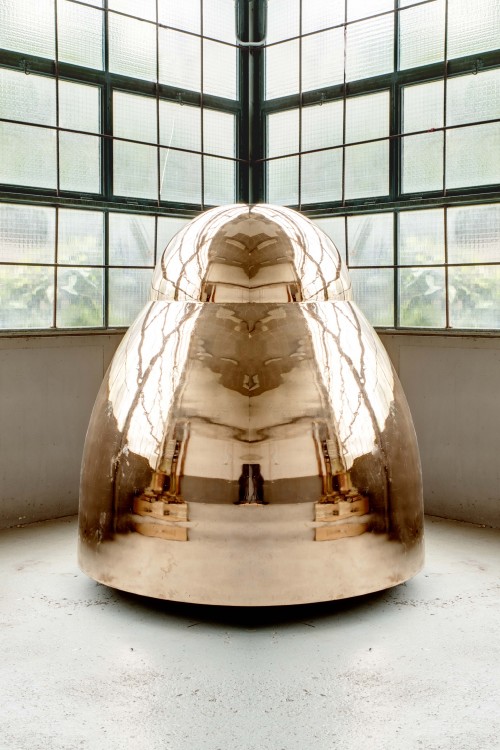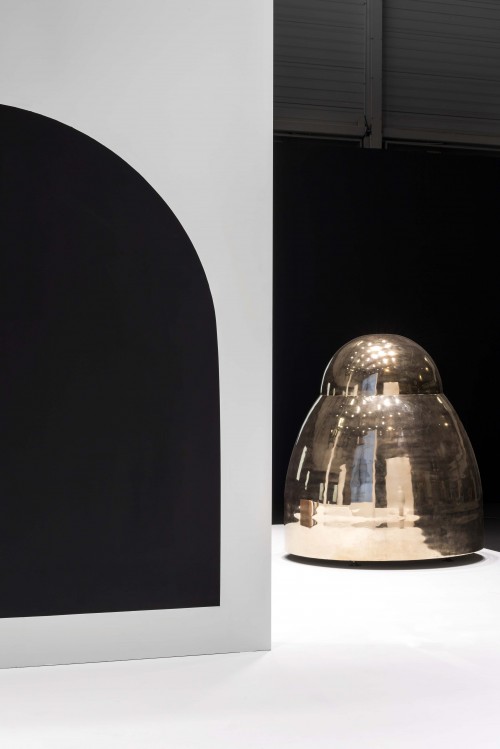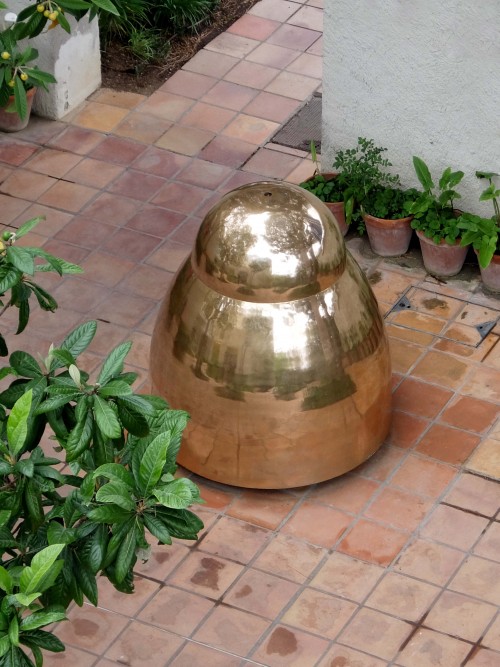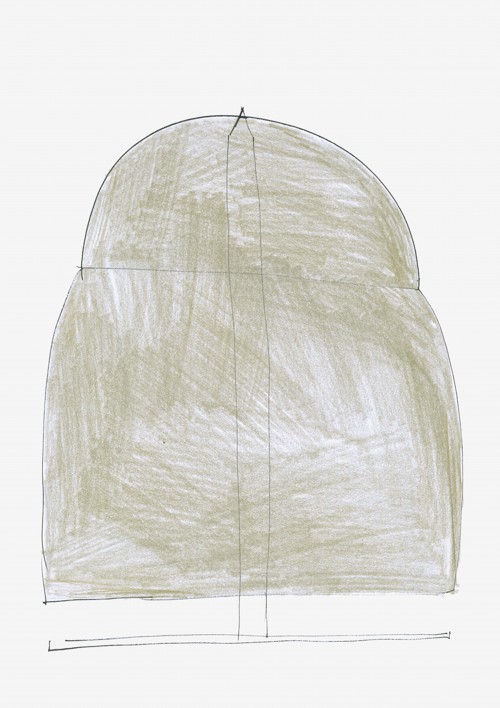The bell
Assessing the possibilities afforded by the specific context is the essential starting point of any new project. In the case of F93, the brief was very open. Only the material to be used was specified: metal.
Metal is a vast area. Having used it in various forms for some of my objects in the past, I am not entirely unfamiliar with it.
I flounder around, undecided about the direction
I want to take. I seek to explore unchartered territory. I want this project to be an opportunity for a new experience.
That is when the acoustic dimension of the material suddenly appears, making it an obvious element to work out. Metal chimes. This is something I have not yet done.
Instantly, the notion of sound brings up the form of a bell, which to me is more a sound object than
a musical instrument. A marker of time, measuring the rhythm of secular or religious life, honoring the married as well as the dead.
Nothing in my background seemed to destine me to design a bell. I barely ever attended church — though I visited some — and when Easter came as a child, it was my brother who always got the chocolate bell. I got the chocolate hen.
I still remember the beautiful bells I staged along with the 800 other objects that composed Alessandro Mendini’s “quali cose siamo” exhibition at the Design Museum during Milan’s Triennial. One of them dates from the year 1000, long before the word “design” even existed.
Whether in a bell tower or attached to an animal’s neck, a bell needs to be suspended in order to vibrate and emit its sound.
Not knowing its purpose or where it would be exhibited in advance, I opted for an arrangement with a central foot placed inside the bell, making it autonomous and movable, in spite of its substantial weight and size.
The bell will be struck from the outside, just like all the bells I admired in the temples of Kyoto, where it is considered an autonomous object, a small edifice in its own right.
For the realisation of the bell the chosen technique is casting. I want a shining object, a reflective presence.
A journey into the very exclusive world of France’s remaining bell-makers. Normandy, one of Orléans’ faubourgs and then Strasbourg, where the bell will be cast.
The sound remains uncertain till the project is completed and the bell is struck. It rings!
The bell’s unusual shape made it impossible to know for certain what its resonance would be.
Come to think of it, it is almost like replaying, without dramaturgy, scenes from Tarkowski’s Andrei Rublev, in which the child Boriska — a survivor of the plague that wiped out the village where his father worked as a bell founder — finds himself overseeing the casting of a bell under the menacing looks of the clergy, with vague memories of the bell-making process as his only knowledge.
The tension is lifted when the bell is removed from the mold, placed on its support and finally rung. The bell can take its place in the tower — the Tartars are defeated.
Boriska can now confess that his wretched father hadn’t passed down any knowledge of his craft to him, and that he had had to invent it all as he went, so as to avoid being beheaded.
He can finally go to sleep and back to his sweet childhood dreams, while Andrei Roublev has begun to speak again, breaking his vow of silence.
Pierre Charpin, 2013
La cloche
Chaque fois que je commence un projet, je cherche avant tout à comprendre ce que la spécificité du contexte peut m’offrir comme possibilités. Dans le contexte de ce projet pour F93 la demande est très ouverte. N’est spécifié que le matériau à utiliser: le métal.
Le métal, c’est vaste. J’en ai une certaine connaissance pour l’avoir utilisé sous différentes formes pour la fabrication de certains de mes objets.
Je tâtonne, j’hésite quant à la direction à prendre. Je cherche à m’engager dans une voie que je ne connais pas. Je veux que ce projet soit l’occasion d’une nouvelle expérience.
Surgit alors la dimension sonore du matériau, pour devenir l’évidence à travailler. Le métal ça sonne. Ça, je ne l’ai pas encore fait.
J’associe immédiatement cette dimension du son à l’objet cloche que j’identifie davantage comme un objet sonore plutôt que comme un instrument de musique. Une présence qui marque le temps, rythme la vie civile ou religieuse, célèbre les mariés et accompagne les morts.
Rien de me destinait à dessiner une cloche. J’ai bien peu fréquenté les églises sauf pour les visiter et, enfant, c’est à mon frère, qu’à Pâques, la cloche en chocolat était systématiquement destinée. A moi la poule.
J’ai encore en tête les très belles cloches que j’ai scénographiées avec les 800 autres objets qui constituaient l’exposition “quali cose siamo” imaginée par Alessandro Mendini pour le Design Muséum de la triennale de Milan. L’une d’elles date de l’an mille, bien avant donc que n’apparaisse le mot design.
Qu’elle soit suspendue à un clocher ou au cou d’un animal domestique, la cloche a toujours besoin d’un support pour pouvoir vibrer et donc sonner.
Ne connaissant pas par avance sa destination, son lieu d’exposition, j’ai opté pour un dispositif à pied central à l’intérieur de la cloche afin de la rendre autonome, déplaçable, malgré son poids et sa dimension conséquente.
La cloche sera frappée de l’extérieur comme toutes celles que j’ai admirées dans les multiples temples de Kyoto, où la cloche est un objet autonome, un petit édifice à part entière.
La fonte est la technique retenue pour sa réalisation. Je veux un objet brillant, une présence réfléchissante.
Voyage dans le monde très fermé des fabricants de cloche encore existant en France. La Normandie, un faubourg d’Orléans et puis Strasbourg. C’est là qu’elle sera coulée.
Quant au son, c’est tout au long du projet la plus totale incertitude jusqu’à ce qu’elle soit enfin frappée. Elle sonne!
Sa forme atypique ne procurait aucune certitude quant à sa capacité sonore.
A y repenser, c’est presque comme rejouer, sans la dramaturgie, les scènes du film Andrei Roublev de Tarkowski où l’enfant Boriska, fils d’un fondeur de cloche, survivant d’un village décimé par la peste, se retrouve à diriger les opérations de fabrication d’une cloche, sous les regards menaçants des religieux, avec comme seule connaissance, la très vague mémoire de ce qu’il a vu de son processus de fabrication.
La tension se dissipe lorsque la cloche est enfin démoulée, placée sur son support et qu’elle sonne. Elle peut prendre place dans son clocher, c’est la victoire sur les Tartares.
Boriska peut maintenant avouer que son maudit père ne lui avait rien transmis de son savoir et qu’il a dû tout réinventer sous peine d’être décapité.
Il peut enfin s’endormir et retourner à ses doux rêves d’enfant alors qu’Andrei Roublev, rompant son voeu de silence, s’est remis à parler.
Pierre Charpin, 2013







